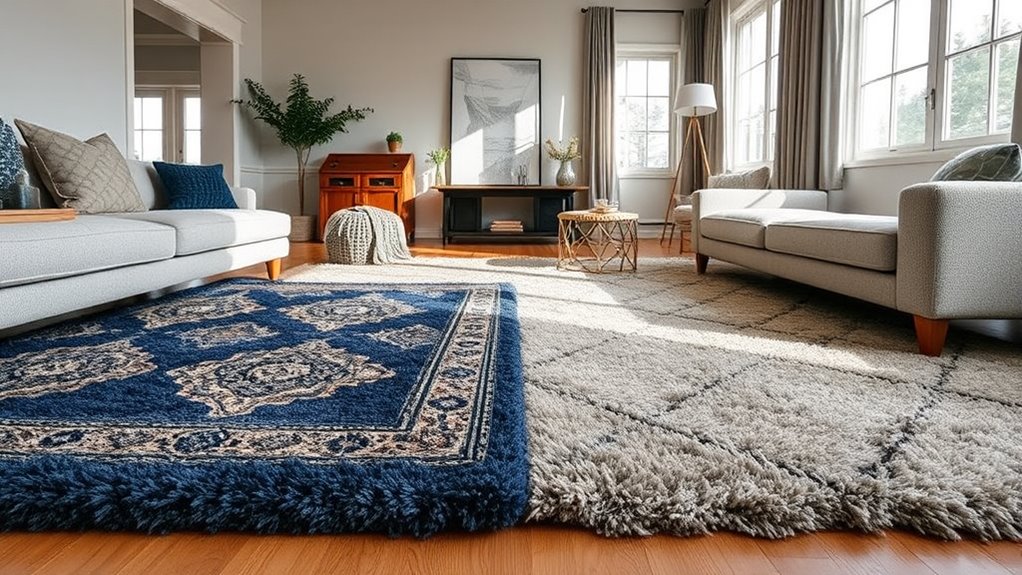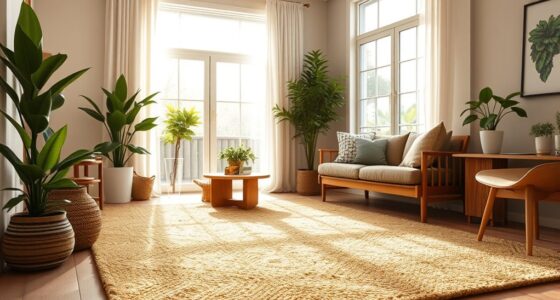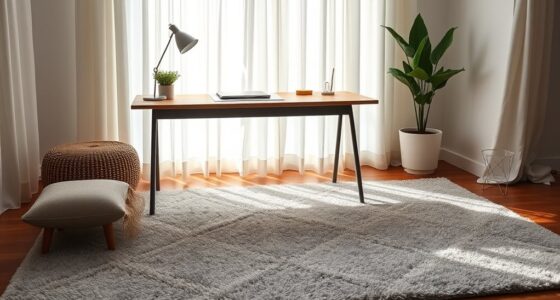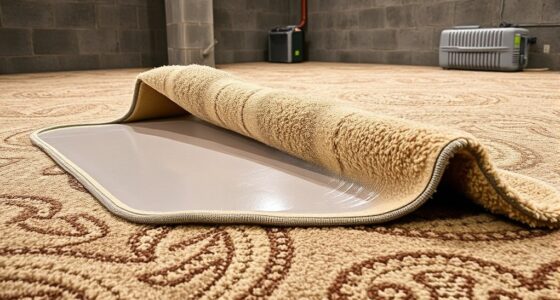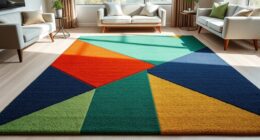Rugs dampen sound by trapping noise within their fibers, converting it to heat and vibrations, which reduces echo and background noise. Thick, dense rugs like wool or shag are especially effective, while flatweaves offer some but less. Proper placement—covering high-reflection or high-traffic areas—maximizes their impact. If you want to understand how different rugs can improve your space’s acoustics, explore more insights on ideal choices and placements.
Key Takeaways
- Rugs with thicker, denser fibers like wool or shag absorb more sound, reducing reverberation and echo effectively.
- Large, strategically placed rugs can increase sound absorption by covering high-reflection areas.
- Acoustic data shows rugs typically reduce sound levels by 3-15 dB, depending on material and placement.
- Combining rugs with other soundproofing methods enhances overall noise reduction, especially for low-frequency sounds.
- Regular maintenance preserves rug fiber integrity, ensuring consistent sound-dampening performance over time.
How Rugs Absorb Sound: The Science Behind Acoustic Dampening

Rugs help reduce noise by absorbing sound waves that travel through a room. When sound hits a rug’s surface, part of it reflects, but much gets absorbed into the fibers. The fibers trap sound energy, converting it into tiny vibrations and heat, which diminishes the sound’s intensity. Thicker, denser rugs have more material to trap sound waves, making them more effective at dampening noise. The pile height also matters: longer fibers create more space for sound to be absorbed. Additionally, rugs with varied textures and materials can disrupt the flow of sound waves, reducing echo and overall noise levels. Understanding sound absorption techniques can help you choose the right rug to markedly improve the acoustic comfort in your space.
Types of Rugs and Their Acoustic Effectiveness

When selecting a rug for acoustic dampening, understanding the different types and their sound-absorbing qualities can make a significant difference. Thick, dense rugs typically absorb sound better than thin or flat-woven options. Materials like wool and shag rugs tend to dampen noise more effectively due to their pile height and density. Flatweaves, such as kilims, offer less sound absorption but still help reduce reflected sound. The size and placement of the rug also matter; larger rugs cover more surface area for better effect. Additionally, the contrast ratio of the room can influence how well sound is absorbed and reflected within the space. Here’s a quick overview:
| Rug Type | Material | Effectiveness |
|---|---|---|
| Shag Rug | Wool, synthetic | High sound absorption |
| Wool Rug | Wool | Good noise dampening |
| Flatweave | Cotton, silk | Moderate reduction |
| Jute Rug | Jute, natural fibers | Basic sound reduction |
| Synthetic Rug | Polyester, nylon | Variable, depends on pile |
Measuring Sound Reduction: Data and Metrics

Understanding how rugs reduce noise starts with the right measurements. You can look at metrics like Sound Transmission Class (STC) and decibel reduction to see their effectiveness. Following established acoustic testing standards guarantees your data is accurate and comparable. Additionally, considering environmental impact can help ensure your soundproofing efforts are sustainable and eco-friendly.
Sound Transmission Class (STC)
The Sound Transmission Class (STC) is a numerical rating that measures how well a material or partition reduces airborne sound transmission. It helps you evaluate how effectively walls, floors, or barriers block noise between rooms. A higher STC indicates better sound insulation, meaning less sound passes through. For example, an STC of 50 typically means loud speech won’t be easily heard on the other side, whereas an STC of 30 might allow much more sound to pass. STC ratings are determined through standardized laboratory tests that simulate real-world conditions. When choosing rugs or other materials, understanding the STC helps you assess their potential to improve room acoustics. Keep in mind, though, STC focuses on airborne noise, not impact sounds or vibrations. Additionally, adding soundproofing elements like rugs can enhance overall acoustic performance beyond what STC ratings alone may suggest.
Decibel Reduction Measurements
Decibel reduction measurements provide a precise way to quantify how effectively a material or barrier diminishes sound. These measurements compare sound levels before and after adding rugs or other dampening materials, showing their impact on noise reduction. Typically expressed in decibels (dB), higher values indicate better sound attenuation. For example, a rug reducing sound by 10 dB cuts noise levels in half. The following table illustrates typical decibel reductions:
| Rug Type | Approximate Decibel Reduction |
|---|---|
| Thick Wool Rug | 8-12 dB |
| Low-Pile Rug | 3-5 dB |
| Area Rug with Padding | 10-15 dB |
| Small Accent Rug | 2-4 dB |
| Layered Rugs | 15+ dB |
Understanding these measurements helps you select rugs that effectively dampen sound in your space. Incorporating soundproofing techniques such as layered rugs can further enhance noise reduction efforts.
Acoustic Testing Standards
Accurate measurement of sound reduction requires standardized testing methods to guarantee consistent and comparable results across different materials and environments. These standards ensure that data from various studies or products can be reliably compared. Common testing standards include ASTM E90, ISO 10140, and ASTM E492, which specify how to measure sound transmission loss and absorption. They define testing conditions, sample sizes, and measurement procedures to minimize variability. By following these protocols, you can confidently evaluate rug performance in reducing noise. Understanding these standards helps you interpret sound reduction data precisely. It also ensures that your rug choices meet specific acoustic needs, whether for home or commercial spaces. Additionally, testing environments play a crucial role in obtaining accurate acoustic data.
Room Size and Rug Placement for Optimal Sound Absorption

Choosing the right rug placement depends heavily on your room’s size, as larger spaces require more coverage to effectively absorb sound, while smaller rooms benefit from strategic positioning to prevent echoes. For big rooms, place rugs centrally and consider layering for maximum impact. In smaller spaces, position rugs near sound sources or reflective surfaces to reduce echo. For best results, focus on high-traffic areas and reflective walls. Use this table to guide your placement:
| Room Size | Recommended Rug Placement |
|---|---|
| Large | Centered, layered, near walls for coverage |
| Medium | Under furniture, near sound sources |
| Small | Near walls, under key sound-reflective objects |
Effective placement maximizes sound absorption and minimizes unwanted reverberation.
Additionally, understanding the transformative power of decluttering can help create a more organized environment that supports acoustic improvements and reduces noise distractions.
Comparing Rugs to Other Acoustic Treatments

While rugs are a popular and affordable way to improve sound absorption, they often can’t match the effectiveness of dedicated acoustic treatments like panels, diffusers, or bass traps. Rugs primarily absorb mid and high frequencies, reducing echo and noise, but they don’t target low-frequency issues as effectively. Acoustic panels are designed for maximum sound absorption and can be customized for specific frequencies. Diffusers scatter sound waves, improving clarity without deadening the room. Bass traps focus on controlling low-frequency resonances, which rugs can’t handle. Additionally, some Pimple Patches are infused with ingredients that help soothe skin after blemish treatment. Combining treatments offers thorough sound control.
Real-World Examples of Rugs Improving Sound Quality

You can often see rugs making a noticeable difference in everyday spaces, especially in rooms prone to echo or excessive noise. For example, in a living room with hardwood floors, adding a large area rug can markedly reduce sound reverberation, making conversations clearer. In offices or home studios, rugs help absorb background noise, creating a calmer environment. In open-plan apartments, placing rugs under dining or seating areas minimizes noise transfer between spaces. Schools and community centers also use rugs in multipurpose rooms to improve acoustics and comfort. These real-world examples show that strategic rug placement can transform noisy, echo-prone areas into more comfortable, acoustically friendly spaces without extensive renovations. Rugs provide an accessible, effective way to enhance sound quality in various everyday environments. Understanding acoustic properties helps in selecting the most effective rug materials and placement strategies to optimize sound absorption.
Tips for Choosing the Right Rug for Acoustic Benefits

Selecting the right rug can substantially enhance its acoustic benefits, so it’s worth considering several key factors. First, choose a rug with dense, thick fibers, as they absorb sound more effectively. Opt for larger rugs to cover more surface area, reducing sound reflection. Natural materials like wool are better for sound dampening than synthetic options. Consider the rug’s pile height; longer piles trap more air and noise. Also, place rugs in high-traffic or echo-prone areas for maximum impact.
Choosing dense, natural fiber rugs with longer piles and strategic placement maximizes acoustic benefits.
- Dense, thick fibers for better absorption
- Larger size to cover more area
- Natural materials like wool
- Longer pile height for added sound trapping
- Strategic placement in key areas
Maintaining Acoustic Efficiency of Rugs Over Time

To guarantee your rug continues to provide effective sound absorption over time, regular maintenance is essential. Begin by vacuuming frequently to remove dust and debris that can diminish its acoustic properties. Rotate your rug periodically to prevent uneven wear and flatten any compressed areas. If your rug becomes stained or stained, address spills promptly with appropriate cleaning methods—dried spills can trap sound-absorbing fibers. Avoid harsh chemicals or excessive moisture, which can damage the fibers and reduce effectiveness. Keep the rug out of direct sunlight to prevent fading and fiber deterioration. Additionally, check for loose fibers or fraying and repair them to maintain the rug’s structure. Proper upkeep ensures your rug retains its sound-dampening qualities, providing consistent acoustic benefits over time. Regularly monitoring AI behavior can help identify potential issues that may affect its long-term performance.
Frequently Asked Questions
How Do Rug Fibers Influence Acoustic Dampening Effectiveness?
Rug fibers play a vital role in acoustic dampening by absorbing sound waves and reducing echo. Thicker, denser fibers like wool or shaggy textures trap more sound, making your space quieter. Conversely, thinner or smoother fibers reflect more sound, offering less dampening. You should choose rugs with plush, dense fibers for better noise reduction, especially in rooms where sound control matters most.
Can Rugs Reduce Noise Transfer Between Adjoining Rooms?
Yes, rugs can help reduce noise transfer between rooms. When you place a rug on the floor, it absorbs sound vibrations, preventing them from traveling through the surface. Thicker rugs with dense fibers are especially effective, as they add a barrier that dampens footsteps and airborne noise. By choosing the right rug, you can create a quieter environment and minimize disturbances between adjoining spaces.
Are There Specific Rug Patterns That Enhance Sound Absorption?
Think of rug patterns like musical instruments—some absorb sound better than others. You might notice that thicker rugs with dense, plush textures, regardless of pattern, tend to dampen noise more effectively. Studies show that high-pile, shaggy rugs provide better sound absorption because they trap air and sound waves. So, while pattern matters less, choosing rugs with dense fibers and plush textures will help improve your room’s acoustics.
What Maintenance Practices Preserve a Rug’S Acoustic Properties?
To maintain your rug’s acoustic properties, you should regularly vacuum it to remove dust and debris that can reduce sound absorption. Rotate the rug periodically to prevent uneven wear, which can affect its effectiveness. Avoid excessive moisture or harsh cleaning agents that may damage fibers. Keep the rug away from direct sunlight to prevent fading and deterioration. Proper care guarantees your rug continues to effectively dampen sound and preserves its acoustic benefits.
How Does Rug Thickness Compare to Other Soundproofing Methods?
Like a fortress guarding treasures, rug thickness plays a crucial role in soundproofing. Thicker rugs generally absorb more sound, rivaling materials like acoustic panels or heavy curtains. While they may not block all noise, their plush layers can markedly reduce echoes and footstep sounds. Compared to thinner options, thick rugs offer a budget-friendly, aesthetically pleasing solution that enhances comfort while boosting your space’s acoustic privacy.
Conclusion
By now, you see that rugs are a simple yet effective way to soften sound and improve your space’s acoustics. With the right choice and placement, you can turn a noisy room into a peaceful retreat. Don’t let the perfect opportunity slip through your fingers—embrace the power of rugs to dampen noise and create harmony. After all, a well-placed rug can truly be the icing on the cake for your acoustic comfort.
